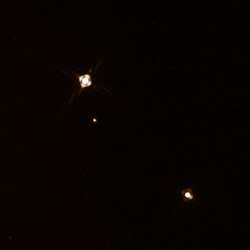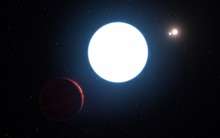HD 131399
 SPHERE image of HD 131399 A (top left), B and C (bottom right), and the background object (center) Credit: ESO/K. Wagner et al. | |
| Observation data Epoch J2000 Equinox J2000 | |
|---|---|
| Constellation | Centaurus |
| Right ascension | 14h 54m 25.30919s[1] |
| Declination | −34° 08′ 34.0412″[1] |
| Apparent magnitude (V) | 7.07[2] |
| Characteristics | |
| Spectral type | A1V + G + K[3] |
| Astrometry | |
| Radial velocity (Rv) | 0.30 ± 1.3[4] km/s |
| Proper motion (μ) | RA: -29.69[1] mas/yr Dec.: -31.52[1] mas/yr |
| Parallax (π) | 10.20 ± 0.70[1] mas |
| Distance | 351+15 −12 ly (107.9+4.5 −3.7[5] pc) |
| Orbit[3] | |
| Period (P) | 3556 ± 36 yr |
| Semi-major axis (a) | 3.56 ± 0.03″ (349 ± 28 au) |
| Eccentricity (e) | 0.13 ± 0.05 |
| Inclination (i) | 45 to 65° |
| Longitude of the node (Ω) | 265 ± 20[note 1]° |
| Periastron epoch (T) | B 502 ± 33 |
| Argument of periastron (ω) (secondary) | 145.3 ± 15[note 2]° |
| Details[5] | |
| Age | 21.9+4.1 −3.8 Myr |
| HD 131399 A | |
| Mass | 2.08+0.12 −0.11 M☉ |
| Surface gravity (log g) | 4.32 ± 0.01 cgs |
| Temperature | 9480+420 −410 K |
| HD 131399 B | |
| Mass | 0.95 ± 0.04 M☉ |
| Surface gravity (log g) | 4.40 ± 0.03 cgs |
| Temperature | 4890+190 −170 K |
| HD 131399 C | |
| Mass | 0.35 ± 0.04 M☉ |
| Surface gravity (log g) | 4.45 ± 0.05 cgs |
| Temperature | 3460 ± 60 K |
| Other designations | |
| Database references | |
| SIMBAD | data |
HD 131399 is a star system in the constellation of Centaurus. Based on the system's electromagnetic spectrum, it is located around 351 light-years (107.9 parsecs) away.[5] The total apparent magnitude is 7.07,[5] but because of interstellar dust between it and the Earth, it appears 0.22 ± 0.09 magnitudes dimmer than it should be.[5][note 3]
The brightest star, is a young A-type main-sequence star, and further out are two lower-mass stars.[3] A Jupiter-mass planet or a low-mass brown dwarf was once thought to be orbiting the central star, but this has been ruled out.[5]
Stellar system
The brightest star in the HD 131399 system is designated HD 131399 A. Its spectral type is A1V,[3] and it is 2.08 times as massive as the Sun.[5] The two lower-mass stars are designated HD 131399 B and C, respectively. B is a G-type main-sequence star, while HD 131399 C is a K-type main-sequence star.[3] Both stars are less massive than the Sun.[5]
HD 131399 B and C are located very close to each other, and the two orbit each other. In turn, the B-C pair orbits the central star A at a distance of 349 astronomical units (au). This orbit takes about 3,600 years to complete, and it has an eccentricity of about 0.13[3] The entire system is about 21.9 million years old.[5]
Planetary system

The discovery of a massive planet, named HD 131399 Ab, was announced in a paper published in the journal Science.[3] The object was imaged using the SPHERE imager of the Very Large Telescope at the European Southern Observatory. It was supposedly a T-type object with a mass of 4 ± 1 MJ,[3] but its orbit would have been unstable, causing it to be ejected between the primary's red giant phase and white dwarf phase.[6]
Observations made by the Gemini Planet Imager and including a reanalysis of the SPHERE data suggest that this target is, in fact, a background star. This object's spectrum seems to be like that of a K-type or M-type dwarf, not a T-type object as first thought. It also initially appeared to be associated with HD 131399, but this was because of its unusually high proper motion (in the top 4% fastest-moving stars).[5]
References
- 1 2 3 4 5 van Leeuwen, F.; et al. (2007). "Validation of the new Hipparcos reduction". Astronomy and Astrophysics. 474 (2): 653–664. arXiv:0708.1752. Bibcode:2007A&A...474..653V. doi:10.1051/0004-6361:20078357.
- ↑ Høg, E.; et al. (2000). "The Tycho-2 catalogue of the 2.5 million brightest stars". Astronomy and Astrophysics. 355: L27–L30. Bibcode:2000A&A...355L..27H.
- 1 2 3 4 5 6 7 8 Wagner, K.; Apai, D.; Kasper, M.; Kratter, K.; McClure, M.; Robberto, M.; Beuzit, J.-L. (2016). "Direct imaging discovery of a Jovian exoplanet within a triple-star system". Science. 353 (6300): 673. arXiv:1607.02525. Bibcode:2016Sci...353..673W. doi:10.1126/science.aaf9671. PMID 27386921.
- ↑ Kharchenko, N. V.; et al. (2007). "Astrophysical supplements to the ASCC-2.5: Ia. Radial velocities of ~55000 stars and mean radial velocities of 516 Galactic open clusters and associations". Astronomische Nachrichten. 328 (9): 889. arXiv:0705.0878. Bibcode:2007AN....328..889K. doi:10.1002/asna.200710776.
- 1 2 3 4 5 6 7 8 9 10 Nielsen, Eric L.; et al. (2017). "Evidence that the Directly-Imaged Planet HD 131399 Ab is a Background Star". The Astronomical Journal. 154 (6): 218. arXiv:1705.06851. Bibcode:2017AJ....154..218N. doi:10.3847/1538-3881/aa8a69.
- ↑ Veras, Dimitri; Mustill, Alexander J.; Gänsicke, Boris T. (2017). "The unstable fate of the planet orbiting the a star in the HD 131399 triple stellar system". Monthly Notices of the Royal Astronomical Society. 465 (2): 1499. arXiv:1611.00007. Bibcode:2017MNRAS.465.1499V. doi:10.1093/mnras/stw2821.
Notes
- ↑ There are two solutions; the other one is 75 ± 10°.
- ↑ There are two solutions; the other one is 310 ± 10°.
- ↑ See Interstellar extinction.